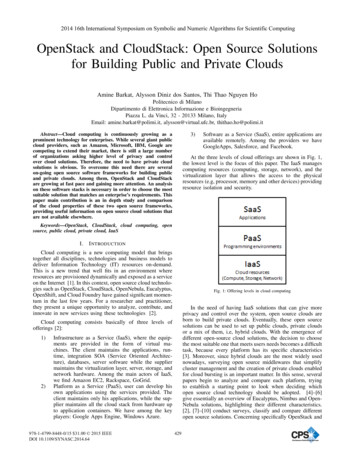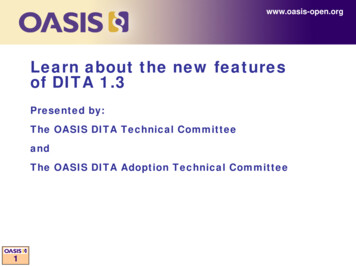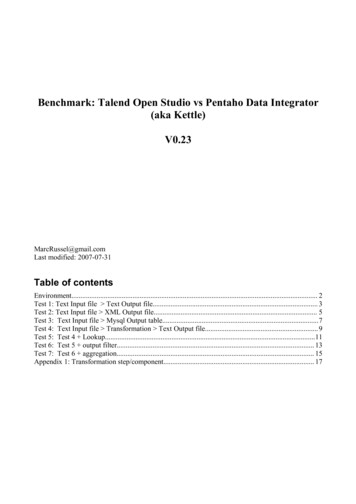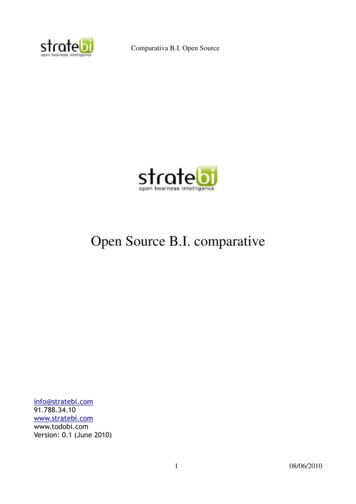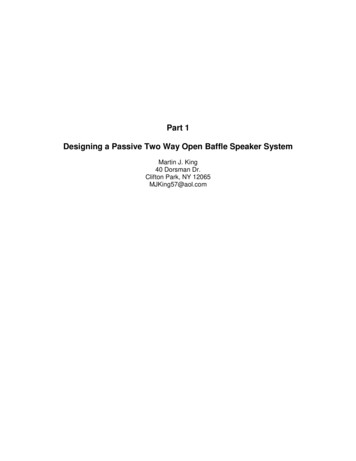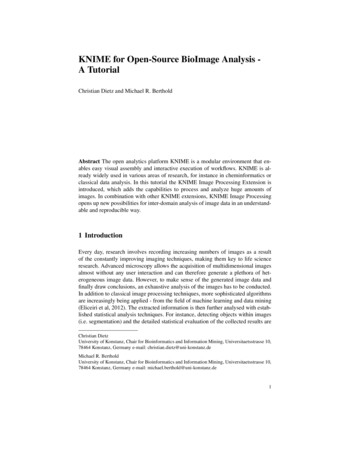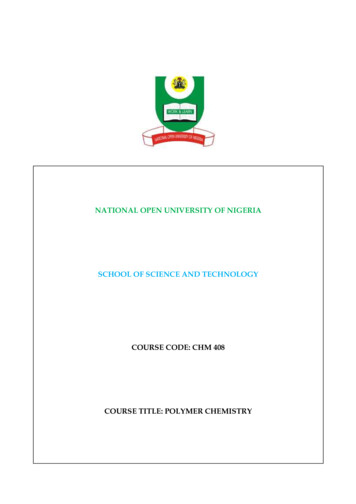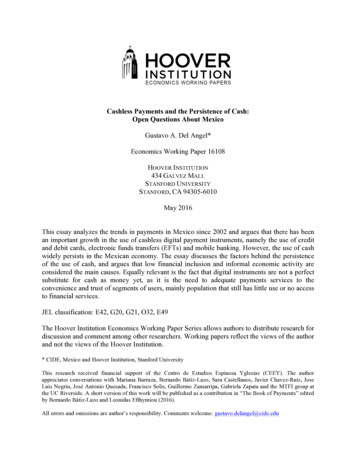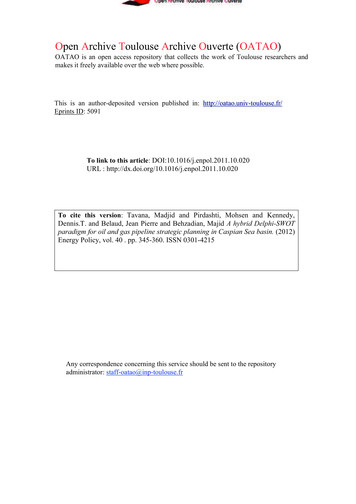
Transcription
Open Archive Toulouse Archive Ouverte (OATAO)OATAO is an open access repository that collects the work of Toulouse researchers andmakes it freely available over the web where possible.This is an author-deposited version published in: http://oatao.univ-toulouse.fr/Eprints ID: 5091To link to this article: DOI:10.1016/j.enpol.2011.10.020URL : http://dx.doi.org/10.1016/j.enpol.2011.10.020To cite this version: Tavana, Madjid and Pirdashti, Mohsen and Kennedy,Dennis.T. and Belaud, Jean Pierre and Behzadian, Majid A hybrid Delphi-SWOTparadigm for oil and gas pipeline strategic planning in Caspian Sea basin. (2012)Energy Policy, vol. 40 . pp. 345-360. ISSN 0301-4215㩷Any correspondence concerning this service should be sent to the repositoryadministrator: staff-oatao@inp-toulouse.fr㩷
A hybrid Delphi-SWOT paradigm for oil and gas pipeline strategic planning inCaspian Sea basin Madjid Tavana a,n, Mohsen Pirdashti b, Dennis T. Kennedy a, Jean-Pierre Belaud c, Majid Behzadian daManagement Information Systems, La Salle University, Philadelphia, PA 19141, USAChemical Engineering Department, Faculty of Engineering, Shomal University, Amol 46134, IrancUniversité de Toulouse, INPT-ENSIACET CNRS Laboratoire de Génie Chimique 4, Allée Emile Monso, 31030 Toulouse Cedex 04, FrancedIndustrial Engineering Department, Faculty of Engineering, Shomal University, Amol 46134, IranbabstractKeywords:Oil and gas pipeline planningCaspian SeaMulti-criteria decision analysisThe Caspian Sea basin holds large quantities of both oil and natural gas that could help meet theincreasing global demand for energy resources. Consequently, the oil and gas potential of the region hasattracted the attention of the international oil and gas industry. The key to realizing the energyproducing potential of the region is the development of transnational export routes to take oil and gasfrom the landlocked Caspian Sea basin to world markets. The evaluation and selection of alternativetransnational export routes is a complex multi-criteria problem with conflicting objectives. Thedecision makers (DMs) are required to consider a vast amount of information concerning internalstrengths and weaknesses of the alternative routes as well as external opportunities and threats tothem. This paper presents a hybrid model that combines strength, weakness, opportunity and threat(SWOT) analysis with the Delphi method.1. IntroductionThe oil and natural gas industry is the backbone of the worldeconomy (Balat, 2010). The rapid economic expansion in developed countries coupled with the growing economies in countriessuch as China and India has precipitated a steady increase in thedemand for energy, especially oil and natural gas (Bambawale andSovacool, 2011a,b; Kun et al., 2011). China has moved to the topspot of energy consumption in 2010 with 20.3% of the globaldemand, ahead of the U.S.’s 19%, according to British Petroleum’s(BP’s) 60th annual statistical review of world energy (2011). TheU.S.’s consumption edged up 3.7% last year compared with an11.2% growth in China. According to BP, the demand for all formsof energy grew 5.6% in 2010. The consumption growth accelerated by 3.5% in the organization for economic co-operation anddevelopment (OECD) countries (which includes 34 countriesincluding the U.S., U.K., France, Germany and Japan) while theE-mail addresses: tavana@lasalle.edu (M. Tavana),pirdashti@shomal.ac.ir (M. Pirdashti), kennedy@lasalle.edu (D.T. Kennedy),JeanPierre.Belaud@ensiacet.fr (J.-P. Belaud),behzadian ie@yahoo.com (M. Behzadian).URL: http://tavana.us (M. Tavana).consumption grew by 7.5% in the non-OECD countries. The vitalimportance of energy together with the constant increase indemand for oil and gas necessitates the exploration, developmentand distribution of new sources of energy.The Caspian Sea is the world’s largest inland sea and has asignificant, but not major, amount of oil and natural gas reserves,based upon estimates by BP Statistical Review of World Energy(2011). The region’s relative contribution to world supplies ofnatural gas is larger than that for oil. The sea is bordered by fivestates of Azerbaijan, Kazakhstan, Turkmenistan, Iran and Russia.Most of the proven energy reserves in the region belongs toKazakhstan and is concentrated in the eastern side of the sea. Asshown in Table 1, Azerbaijan possesses both oil and natural gasreserves while Turkmenistan possesses mostly natural gas. Russiaand Iran hold inconsequential proven reserves in their respectiveCaspian sectors.According to BP Statistical Review of World Energy (2011)shown in Table 2, proven oil reserves for the Caspian Sea regionare estimated at 47.4 billion barrels at the end of 2010 (ranked8th in world), comparable to those in Libya (46.4 billion barrels).Natural gas reserves in the Caspian Sea region are even largerthan the region’s oil reserves. Overall, proven natural gas reservesin the Caspian region are estimated at 11.1 trillion cubic meters atthe end of 2010 (ranked 4th in world), greater than Saudi Arabia(8.0 trillion cubic meters) and United States (7.7 trillion cubicmeters).
Table 1Caspian oil and natural gas proved reserves—at end 2010.Source: BP Statistical Review of World Energy (2011).Main producers inthe Caspian SeaOil reserves(billion barrels)Gas reserves(trillion cubic 601.801.308.00Table 2Top world countries with oil and natural gas proved reserves—at end 2010.Source: BP Statistical Review of World Energy (2011).OilGasCountry(region)Oil reserves(billionbarrels)Country (region)Gas reserves(trillion cubicmeters)Saudi ArabiaVenezuelaIranIraqKuwaitUnited Arab EmiratesRussian FederationCaspian Sea .4Russian FederationIranQatarCaspian Sea regionSaudi ArabiaUSUnited Arab .55.3Despite its modest volumes, Caspian energy has attractedextensive global policy interest during the past two decades.The intense international focus on the region is driven by itsgeopolitical significance and its unique landlocked location. TheCaspian Sea region is on a major junction between Europe andAsia and positioned nearby Russia and China. In addition, due toits landlocked location, the Caspian exporters are dependent onother states for moving their energy products. The control of theoil and gas pipelines in the region provides significant influenceover the security and policies of the Caspian states. Thus, therecent intense interest in the Caspian region and the battle overthe pipeline routes has been more about determining the geostrategic orientation of the region and had little to do with thecontrol of the Caspian states’ modest volumes of oil and gas.Delimitation of the sea borders has been a contested issue in thelast two decades among the Caspian states. However, legaldisputes have not been an obstacle to the production and exportof oil and gas (Shaffer, 2010). The major obstacles to the development of new supplies were not related to undergroundresources but what happens above the ground such as international relations, governmental affairs and investment in energyand new technological development (Umbach, 2010).In spite of the potential for the Caspian states to meet theincreasing global demand for energy resources, only a fewCaspian oil and natural gas export projects have become operational in the region over the last decade (Shaffer, 2010). Bilgin(2007, 2010), Guliyev and Akhrarkhodjaeva (2009), Kakachia(2011), Newnham (2011), Pasquare et al. (2011), Shaffer (2010)and Umbach (2010) have introduced a large number of factorsthat has played a significant role in shaping the Caspian energydevelopments. These factors take into consideration political(Russian influence in the region), economical, social and geological issues.In this study, we identify and quantify a total of 79 factors thatwill shape the future of Caspian oil and natural gas export. Indoing so, we propose a hybrid model for evaluating five potentialpipeline routes for transporting the oil and gas from the CaspianSea region to the world market. The model integrates strength,weakness, opportunity and threat (SWOT) analysis with theDelphi method and captures the DMs’ beliefs through a series ofintuitive and analytical methods. The next section presents thedetails of the Delphi-SWOT hybrid paradigm followed by itsapplication to the gas and oil pipeline evaluation in the CaspianSea. The final section presents the conclusions and future researchdirections.2. The Delphi-SWOT hybrid paradigmStrategy development is a complex and uncertain process thatidentifies and evaluates alternatives for utilizing an organization’sresources to achieve its mission (Li et al., 2002). Because of actualuncertainty and perceived ambiguity, the process of strategydevelopment requires input from and cooperation of manyorganizational functions and DMs (Li et al., 2000; Mintzberg,1994a,b; Eden, 1990; Porter, 1987). The hybrid Delphi-SWOTparadigm proposed in this study is used to identify and evaluatestrategies for locating a pipeline to transport oil and gas from theCaspian basin to world markets.The Delphi method was developed at the RAND Corporation toobtain the most reliable consensus of opinion from a group ofknowledgeable individuals about an issue not subject to objectivesolution (Dalkey and Helmer, 1963). It is a structured groupinteraction that proceeds through multiple rounds of opinioncollection and anonymous feedback. Although Delphi dates backto early 1950s, the most recognized description of the methodwas offered by Linstone and Turoff (1975). Fischer (1978),Schmidt (1997), Okoli and Pawloski (2004) and Keeney et al.(2006) also provide excellent reviews.Each round in Delphi involves a written survey of the participants followed by statistical feedback to them for each surveyquestion. After seeing the results from the previous round, theparticipants are asked to reconsider their opinions. Generally,there is a convergence of opinions after three or four rounds, anda stabilized group opinion emerges. This group opinion mayreflect agreement, disagreement or some of each. The optimumnumber of participants depends on the number needed to have arepresentative pooling of views (Ndour et al., 1992).Since its inception in the early 1950s, SWOT analysis has beenused with increasing success as a strategic planning tool by bothresearchers and practitioners (Learned et al., 1965; Panagiotou,2003). The technique is used to segregate environmental factorsand forces into internal strengths and weaknesses and externalopportunities and threats (Valentin, 2001; Duarte et al., 2006).The SWOT matrix developed by Weihrich (1982) for situationalanalysis is one of the most important references in the field. Evenwith its popularity, Novicevic et al. (2004) observe that SWOT is aconceptual framework with limited prescriptive power. However,SWOT remains a useful tool for assisting DMs to structurecomplex and ill-structured problems (Hitt et al., 2000; Andersonand Vince, 2002).3. Delphi-SWOT pipeline planning processThis study was conducted for the Horizon Oil Company,1 amultinational oil and natural gas producer. The mission of thecompany is the exploration, development, production and marketing of crude oil and natural gas. Horizon established a group of1The name of the company and some details of the study have been changedto protect the anonymity of the company and the security of strategy.
informed individuals to pool expertise from many domains andevaluate several alternative routes for transporting Caspian oiland gas to the world energy markets. The group included fivesenior managers and two external facilitators. A common groupdecision making activity is evaluating and deciding upon variousalternatives (Ngwenyama and Brysona, 1999). Decision makingbodies in organizations are often formed as groups to evaluatedecision alternatives by collecting and synthesizing informationfrom different perspectives. Group decision making is an effectiveway to overcome judgment errors in organizations due to humanfallibility (Koh, 1994). Maier (2010) summarizes the virtues ofgroup decision making as follows: first, if every group memberexerts effort to become informed, groups can gather moreinformation than individual members. Better information canlead to better decisions. Second, if all group members have thesame information, they may not reach the same conclusion sincegroup members typically have different backgrounds and experiences. Third, if some information is erroneous, a group can poolsignals and reduce uncertainty. Fourth, groups provide an insurance against extreme preferences of individual DMs. The keyduties and responsibilities of the group at Horizon included thefollowing:(a) Identifying and selecting the most preferable route for transporting Caspian oil and gas.(b) Overseeing all phases of the evaluation process.(c) Resolving conflicts as they arise.(d) Developing an action plan for the selected route.(e) Obtaining the approval of the top management in the implementation of the action plan.The five senior managers were highly educated. Three managers held graduate degrees in engineering, one held a graduatedegree in economics and one held a graduate degree in management. Although the members of the group were educated, theirmanagerial judgment and intuition were limited by their background and experience. Nevertheless, all five group memberswere veteran mangers with 15–43 years of experience in the oiland gas industry. The fact that the group members held differentkinds of knowledge made it more likely that all aspects of thedecision will come under consideration. In addition, the groupalso relied on 27 researchers and experts at Horizon whoconducted research interviews and collected data over the courseof two years from different stakeholders involved in oil andnatural gas exploration, production, transmission and distri
Since its inception in the early 1950s, SWOT analysis has been used with increasing success as a strategic planning tool by both researchers and practitioners (Learned et al., 1965; Panagiotou, 2003). The technique is used to segregate environmental factors and forces into internal strengths and weaknesses and external opportunities and threats (Valentin, 2001; Duarte et al., 2006). The SWOT .
